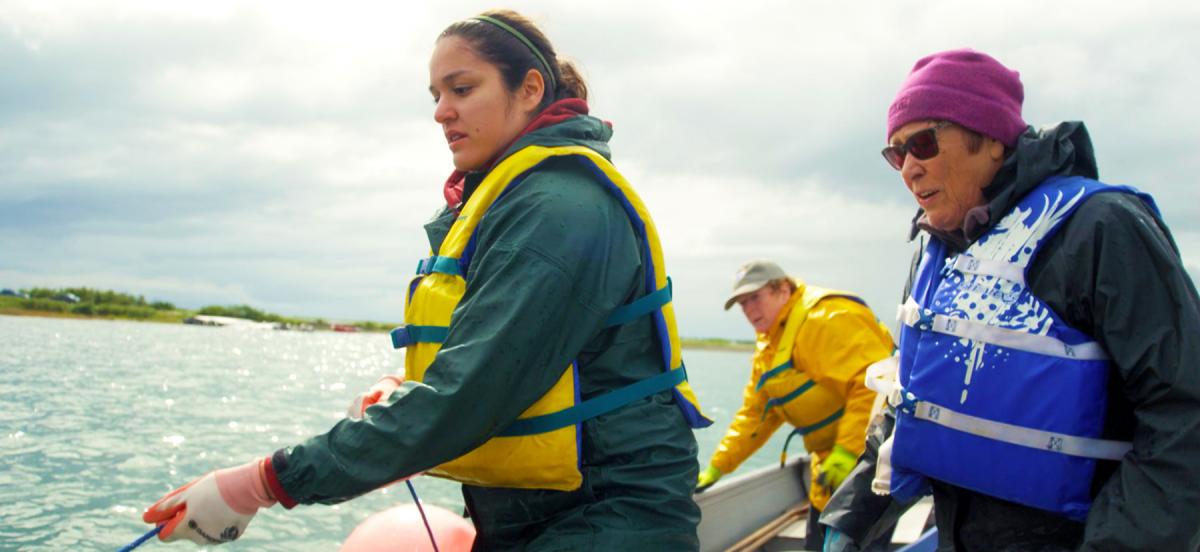Amira Abujbara's "We Are Still Here"

In a scene from the documentary We Are Still Here, Amira Abujbara ‘17 helps out with salmon fishing in the remote village in Alaska where her mother was raised.
Details
The Class of 2017 graduate made a documentary that tells the story of the problems facing Native Alaskan communities.
The daughter of an Alaska Native mother and a Qatari father, Amira Abujbara ’17 has always had one foot in and one foot outside of two very different worlds. Growing up, she attended an international school in Doha, a Persian Gulf city with a population of 1.8 million people, and spent summers in Iliamna, Alaska, a village of less than 200 people best reached via a 50-minute air taxi flight from Anchorage.
Now a Doha-based journalist, Abujbara’s unique personal story has given shape to We Are Still Here: A Story of Native Alaska, a documentary that shines a light on the ongoing challenges facing the tight-knit rural community where people live off the land, jobs are scarce, and a proposed gold-copper mine could save the community—or destroy it.
“The subsistence way of life is just not common in America, and explaining something within U.S. borders but foreign to so many Americans is fun,” says Abujbara, who works as an assistant producer in the online department of the Qatari cable news channel Al Jazeera English. “It’s almost like the Qatari side is easier to explain than the Alaskan side.”
Abujbara, an English major and an environmental studies minor, remembers meeting a handful of other students of Arab descent at the College. She met even fewer classmates with indigenous roots. Still, she felt comfortable on campus.
“One of the good things about Haverford is people are so curious, so even if they don’t know about your cultural background before they meet you, it’s something they’d look up after a conversation to ask about later,” she says. “Even when people didn’t know about Qatar or Alaska Native culture, I always felt I could be proud because they wanted to learn. It was a really nice thing.”
Majoring in English helped Abujbara hone the critical-thinking skills that have served her well since she began working for Al Jazeera—first as an intern in the summers between academic years, then as a full-time employee after graduation.
“You can tell a story in so many ways. There isn’t a template or a right way or a wrong way,” she says. “Just having the ability to analyze and knowing what makes a good story plays a role in what I do now.”
Haverford also helped her develop her social conscience, she says, showing her the importance of allowing people of different backgrounds to have a voice.
“When you have diverse voices and diverse people in charge, you ultimately end up with a much better product,” she says. “It strengthens you, and you can tell a beautiful story or run a business well. That’s something Haverford instilled in me.”
Abujbara and native Hawaiian filmmaker Ciara Lacy filmed on location in Qatar and Alaska. They were in Iliamna during the summer sockeye salmon run as residents, including Abujbara’s grandparents, prepared, smoked, and stored fish for winter. Being skilled with a fillet knife gave the journalist “a nice way to break the ice” as she joined villagers at work while asking delicate questions about the challenges they’re facing.
Since the documentary’s release in late 2018, Abujbara has heard from communities facing the same political, cultural, and environmental challenges, and the film (which can be viewed on YouTube) has prompted discussions of how best to move forward in an ever-challenging world. Some of the Native ways, Abujbara says, may hold the answers.
“We’re at a point in the world, in practical terms, that what we’re doing isn’t working,” she says. “Indigenous communities have been thinking about this for a long time and have ideas for balancing traditional and modern life.”



